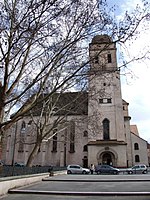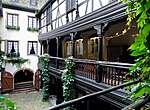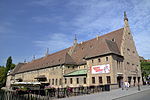Conservatoire de Strasbourg
1839 establishments in FranceDance schools in FranceEducational institutions established in 1839Music schools in France
The Conservatoire de Strasbourg is a music conservatory located in Strasbourg, France. The school was created using funds given to the city of Strasbourg by arts patron Louis Apffel in 1839. The conservatoire's first day of classes began on 3 January 1855.
Excerpt from the Wikipedia article Conservatoire de Strasbourg (License: CC BY-SA 3.0, Authors).Conservatoire de Strasbourg
Place Dauphine, Strasbourg Neudorf
Geographical coordinates (GPS) Address Phone number Website Nearby Places Show on map
Geographical coordinates (GPS)
| Latitude | Longitude |
|---|---|
| N 48.5744 ° | E 7.7557 ° |
Address
Cité de la Musique et de la Danse
Place Dauphine 1
67076 Strasbourg, Neudorf
Grand Est, France
Open on Google Maps










